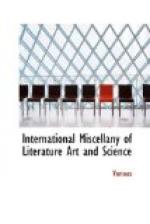On the death of Lawrence in 1830, Shee was elected President of the Royal Academy, and immediately knighted. His election was by a large majority, though Wilkie was a candidate; the members being governed in their votes rather, it is said, by the necessities of their annual dinner than by their sense of the merits of Shee as a painter. He excelled in short, well-timed and well-delivered speeches. He was seldom at a loss; and so highly was his eloquence appreciated within the walls of the Academy, that it had been common with more than one Royal Academician to remark whenever a great speaker was mentioned—“Did you ever hear the President—you should hear the President,”—as if Canning and Stanley had been united in Sir Martin Archer Shee.
He has but little claim to be remembered as a poet. His verse wants vigor, and his examples are deficient in novelty of illustration. The notes to both his poems are, however, valuable, and his poetry is perhaps more frequently read for its prose illustrations than for the beauty of its versification or the value of the truths which it seeks to inculcate. As a portrait-painter he was eclipsed by several or his contemporaries,—by Lawrence and by Hoppner,—by Phillips, Jackson, and Raeburn. He had a fine eye for color; while his leading want was, proportion, more especially in his heads. Compare his head of Chantrey with the portraits of Chantrey by Jackson and Raeburn, and the defect is at once obvious; or compare his head of Mr. Hallam with the head of Mr. Hallam by Phillips, or with the living head—since happily Mr. Hallam is still among us. How, then, it will be asked, is Sir Martin to be remembered: by his poems or by his portraits?—by his speeches or by his annual addresses to the students? The question is not difficult of solution. His pictures in the Vernon Gallery will not preserve his name, nor will his portraits viewed as works of Art. His name will scend in the History of Painting as a clever artist with greater accomplishments than have commonly fallen to the class to which he belongs,—and as the painter who has preserved to us the faces and figures of Sir Thomas Munro, Sir Thomas Picton, Sir Eyre Coote, Sir James Scarlett, and Sir Henry Halford. There was merit, we may add, in his portrait of the poet Moore. Principally, however, he will be remembered as one of the Presidents of the Royal Academy.
* * * * *
GERARD TROOST, M.D.
Dr. GERARD TROOST, for a long period one of the most eminent naturalists of the United States, died on the 14th of August at Nashville, where he had been for twenty years Professor of Chemistry and Natural History in the University of Tennessee. A native of Holland, and educated in one of her universities, he devoted himself to the natural sciences. For the sake of improvement he visited Paris, and for several years was a pupil of the celebrated Hauy.




